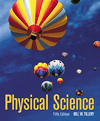The previous chapters have been concerned with mechanical concepts, explanations
of the motion of objects that exert forces on one another. These concepts were
used to explain straight-line motion, the motion of free fall, and the circular
motion of objects on the earth as well as the circular motion of planets and
satellites. The mechanical concepts were based on Newton's laws of motion and
are sometimes referred to as Newtonian physics. The mechanical explanations
were then extended into the submicroscopic world of matter through the kinetic
molecular theory. The objects of motion were now particles, molecules that exert
force on one another, and concepts associated with heat were interpreted as
the motion of these particles. In a further extension of Newtonian concepts,
mechanical explanations were given for concepts associated with sound, a mechanical
disturbance that follows the laws of motion as it moves through the molecules
of matter. You might wonder, as did the scientists of the 1800s, if mechanical interpretations
would also explain other natural phenomena such as electricity, chemical reactions,
and light. A mechanical model would be very attractive since it already explained
so many other facts of nature, and scientists have always looked for basic,
unifying theories. Mechanical interpretations were tried, as electricity was
considered as a moving fluid, and light was considered as a mechanical wave
moving through a material fluid. There were many unsolved puzzles with such
a model and gradually it was recognized that electricity, light, and chemical
reactions could not be explained by mechanical interpretations. Gradually, the
point of view changed from a study of particles to a study of the properties
of the space around the particles. In this chapter you will learn about electric
charge in terms of the space around particles. This model of electric charge,
called the field model, will be used to develop understandings about electric
current, the electric circuit, and electrical work and power. A relationship
between electricity and the fascinating topic of magnetism is discussed next,
including what magnetism is and how it is produced (Figure 7.1). The relationship
is then used to explain the mechanical production of electricity, explain how
electricity is measured, and how electricity is used in everyday technological
applications. |



 2002 McGraw-Hill Higher Education
2002 McGraw-Hill Higher Education

 2002 McGraw-Hill Higher Education
2002 McGraw-Hill Higher Education